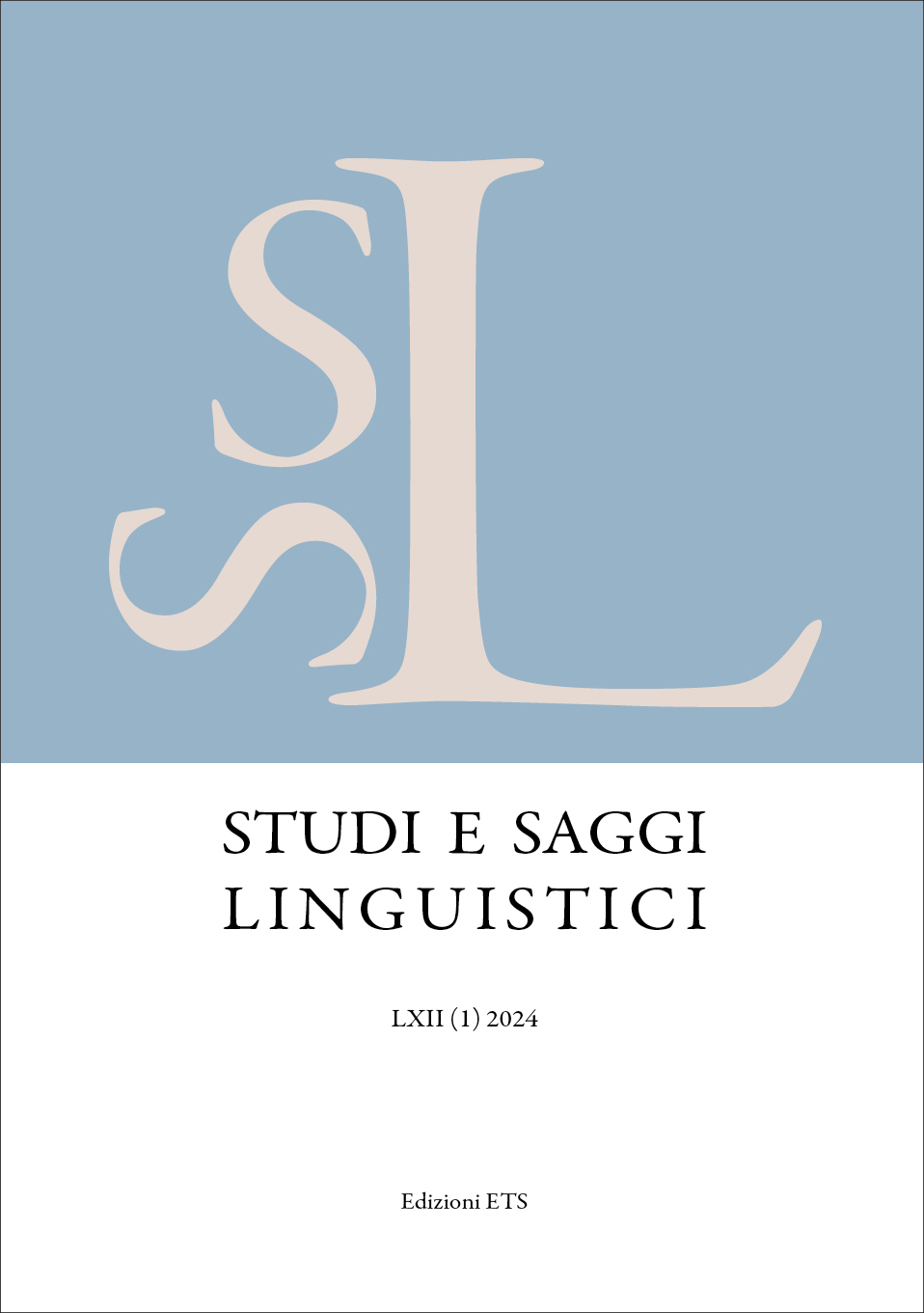A morphosyntactic and morphosemantic analysis of English slang suffixoids
Publiée 2024-07-11
Mots-clés
- English slang,
- morphosyntactic patterns,
- schemas,
- suffixoids,
- Construction Morphology
Résumé
This study investigates English slang suffixoids (Sfxds) such as -ass (in fat-ass), -brain (in birdbrain), -face (in shitface), and -head (in airhead) from the morphosyntactic and morphosemantic viewpoints. Hitherto, the productivity of these morphological elements and their transitional character, borderline between compounding and derivation, have been amply demonstrated. In this study, the focus is on the two privileged morphosyntactic patterns creating denominal and deadjectival nouns – i.e. [[X]N [Sfxd]N]N and [[X]A [Sfxd]N]N – and on their literal or figurative interpretation. A qualitative analysis of a dataset drawn from the Corpus of Contemporary American English (COCA) and Green’s Dictionary of Slang (2023) shows the general metonymic nature of suffixoids, referring to individuals, hence conveying the seme [human] by making reference to one of their body parts with a negative [pejorative] intent. By adopting a construction morphology approach, the analysis aims at finding out regular schemas for the scrutiny and understanding of English nouns displaying a slang suffixoid, as well as for the prediction of new words.
Références
- AMIOT, D., and DUGAS, E. (2021), Combining forms and affixoids in morphology, in LIEBER, R. (2021, ed.), The Oxford Encyclopedia of Morphology, Oxford University Press, Oxford, https://www.oxfordreference.com/view/10.1093/acref/9780190682361.001.0001/acref-9780190682361-e-569.
- AUTHOR (2008).
- AUTHOR (2017).
- AUTHOR (2019).
- AUTHOR (2022).
- AUTHOR (2023).
- BAAYEN, H.R. (1993), On frequency, transparency and productivity, in BOOIJ, G. and VAN MARLE J. (1993, eds.), Yearbook of Morphology 1992, Kluwer Academic Publishers, Dordrecht, pp. 181-208.
- BAUER, L. (2001), Morphological Productivity, Cambridge University Press, Cambridge.
- BAUER, L. (2017), Compounds and Compounding, Cambridge University Press, Cambridge.
- BAUER, L. (2022), Interlocking paradigms in English compounds, in RUZ, A.E., FERNÁNDEZ-ALCAINA, C. and LARA-CLARES, C. (2022, eds.), Paradigms in Word Formation: Theory and Applications, John Benjamins, Amsterdam/Philadelphia, pp. 59-68.
- BOOIJ, G. (2009), Word-formation templates and the hierarchical lexicon, in LIEBER, R. and ŠTEKAUER, P. (2009, eds.), The Oxford Handbook of Compounding, Oxford University Press, Oxford, 201-216.
- BOOIJ, G. (2010), Construction Morphology, Oxford University Press, Oxford.
- BOOIJ, G.E., and HÜNING, M. (2014), Affixoids and constructional idioms, in BOOGAART, R., COLLEMAN, T. and RUTTEN, G. (2014, eds.), Extending the Scope of Construction-based Grammar, de Gruyter, Berlin/Boston, pp. 77-106.
- BOOIJ, G. (2015), The nominalization of Dutch particle verbs: Schema unification and second or-der schemas, in «Nederlandse Taalkunde», 20, pp. 285-314.
- BOOIJ, G. (2019), The role of schemas in Construction Morphology, in «Word Structure», 12, pp. 385-395.
- DAVIES, M. (2008–), Corpus of Contemporary American English (COCA), https://corpus.byu.edu/coca/.
- DOWNING, P. (1977), On the creation and use of English compound nouns, «Language», 53, pp. 810-842.
- GOLDBERG, A. (1995), Constructions. A Construction Grammar Approach to Argument Structure, Chicago University Press, Chicago.
- GOLDBERG, A. (2006), Constructions at Work. The Nature of Generalization in Language, Oxford University Press, Oxford.
- GREEN, J. (2023), Green’s Dictionary of Slang, https://greensdictofslang.com/.
- JACKENDOFF, R. (2002), Foundations of Language, Oxford University Press, Oxford.
- JESPERSEN, O. (1942), A Modern English Grammar on Historical Principles. Part VI: Morphology, Ejnar Munksgaard, Copenhagen.
- MATISOFF, J. (1991), Areal and universal dimensions of grammaticalization in Lahu, in TRAUGOTT, E.C. and HEINE, B. (1991, eds.), Approaches to Grammaticalization: Vol. II, John Benjamins, Amsterdam/Philadelphia, pp. 383-454.
- PAUL, H. (1880), Prinzipien der Sprachgeschichte, Max Niemeyer, Halle.
- PAUL, H. (1891), Principles of the History of Language, Translated by STRONG, H.A. from the second edition of the original, Longmans, Green and Co., London.
- SÁNCHEZ FAJARDO, J.A. (2022), Pejorative Suffixes and Combining Forms in English, John Benjamins, Amsterdam/Philadelphia.
- SÁNCHEZ FAJARDO, J.A. and AUTHOR (forth.).
- STEVENS, C.M. (2005), Revisiting the affixoid debate. On the grammaticalization of the word, in LEUSCHNER, T., MORTELMANS, T. and DE GROODT, S. (2005, eds.), Grammatikalisierung im Deutschen, de Gruyter, Berlin/New York, pp. 71-83.
- WARREN, B. (1990), The importance of combining forms, in DRESSLER, W.U., LUSCHÜTZKY, H.C., PFEIFFER, O.E. and RENNISON, J.R. (1990, eds.), Contemporary Morphology, de Gruyter, Belin/New York, pp. 111-132.
